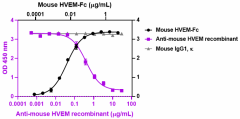- Clone
- QA19A74 (See other available formats)
- Regulatory Status
- RUO
- Other Names
- Herpesvirus Entry Mediator, HVEA, TR2, Tumor Necrosis Factor Receptor Superfamily 14, TNFRSF14
- Isotype
- Mouse IgG1, κ
- Ave. Rating
- Submit a Review
- Product Citations
- publications

-

Recombinant mouse HVEM-Fc chimera (Cat. No. 771302) (black circles) binds to immobilized recombinant mouse BTLA-Fc chimera (Cat. No. 775804). Ultra-LEAF™ purified anti-mouse HVEM recombinant (clone QA19A74) (purple squares) inhibits the binding in a dose-dependent manner, whereas the Ultra-LEAF™ purified mouse IgG1, κ Isotype Control (Cat. No. 401408) (gray triangles) does not have effect. This antibody blocks the binding of 0.1 µg/mL recombinant mouse HVEM-Fc chimera to 1 µg/mL immobilized recombinant mouse BTLA-Fc chimera. ND50 range: 0.1 – 0.6 µg/mL
| Cat # | Size | Price | Quantity Check Availability | Save | ||
|---|---|---|---|---|---|---|
| 632853 | 100 µg | 348€ | ||||
| 632854 | 1 mg | 872€ | ||||
HVEM (Herpes virus entry mediator), also known as TNFRSF14, is a member of the tumor necrosis factor (TNF) receptor family that mediates herpes virus entry into cells during infection. Upon overexpression, HVEM activates NF-κB and AP-1 through a TNF receptor-associated factor (TRAF)-mediated mechanism. HVEM ligands belong to two distinct families: the TNF-related cytokines LIGHT and lymphotoxin-α, and the Ig-related membrane proteins BTLA and CD160. HVEM and its ligands have been involved in the pathogenesis of various autoimmune and inflammatory diseases, tumor progression and resistance to immune response. It has been demonstrated that HVEM induces a novel signaling pathway downstream leading to signal transduction and activation of STAT3 in epithelial cells. Since STAT3 regulates the expression of genes important for host defense in epithelial cells, as well as the differentiation of retinoid-related orphan receptor RORγt+ driven Th17, and innate lymphoid cells. This finding suggests that HVEM may play an important role in mucosal host defense.
Product DetailsProduct Details
- Verified Reactivity
- Mouse
- Antibody Type
- Recombinant
- Host Species
- Mouse
- Immunogen
- Mouse HVEM-Fc Chimera
- Formulation
- 0.2 µm filtered in phosphate-buffered solution, pH 7.2, containing no preservative.
- Endotoxin Level
- < 0.01 EU/μg of the protein (< 0.001 ng/μg of the protein) as determined by the LAL test
- Preparation
- The Ultra-LEAF™ (Low Endotoxin, Azide-Free) antibody was purified by affinity chromatography.
- Concentration
- The antibody is bottled at the concentration indicated on the vial, typically between 2 mg/mL and 3 mg/mL. To obtain lot-specific concentration and expiration, please enter the lot number in our Certificate of Analysis online tool.
- Storage & Handling
- The antibody solution should be stored undiluted between 2°C and 8°C. This Ultra-LEAF™ solution contains no preservative; handle under aseptic conditions.
- Application
-
Block - Quality tested
- Recommended Usage
-
Each lot of this antibody is quality control tested by blocking the binding of 0.1 µg/mL recombinant mouse HVEM-Fc chimera to 1 µg/mL immobilized recombinant mouse BTLA-Fc. ND50 range: 0.1 – 0.6 µg/mL. It is recommended that the reagent be titrated for optimal performance for each application.
Antigen Details
- Structure
- Dimer
- Distribution
-
Spleen, thymus, lung, macrophages, B cells and T cells
- Function
- HVEM plays a role in mucosal host defense, autoimmune and inflammatory diseases, and tumor progression.
- Ligand/Receptor
- BTLA, CD160, LIGHT, lymphotoxin-α
- Biology Area
- Cell Adhesion, Cell Biology, Immunology, Signal Transduction
- Molecular Family
- Adhesion Molecules, CD Molecules, Immune Checkpoint Receptors, Soluble Receptors
- Antigen References
-
- Pasero C, et al. 2012. Curr Opin Pharmacol. 12:478-85.
- Hsu H, et al. 1997. J Biol Chem. 272:13471-4.
- Mauri DN, et al. 1998. Immunity. 8:21-30.
- Montgomery RI, et al. 1996. Cell. 87:427-36.
- Shui JW, et al. 2012. Nature. 488:222-5.
- Gene ID
- 230979 View all products for this Gene ID
- UniProt
- View information about HVEM on UniProt.org
Related FAQs
- Do you guarantee that your antibodies are totally pathogen free?
-
BioLegend does not test for pathogens in-house aside from the GoInVivo™ product line. However, upon request, this can be tested on a custom basis with an outside, independent laboratory.
- Does BioLegend test each Ultra-LEAF™ antibody by functional assay?
-
No, BioLegend does not test Ultra-LEAF™ antibodies by functional assays unless otherwise indicated. Due to the possible complexities and variations of uses of biofunctional antibodies in different assays and because of the large product portfolio, BioLegend does not currently perform functional assays as a routine QC for the antibodies. However, we do provide references in which the antibodies were used for functional assays and we do perform QC to verify the specificity and quality of the antibody based on our strict specification criteria.
- Does BioLegend test each Ultra-LEAF™ antibody for potential pathogens?
-
No, BioLegend does not test for pathogens in-house unless otherwise indicated. However, we can recommend an outside vendor to perform this testing as needed.
- Have you tested this Ultra-LEAF™ antibody for in vivo or in vitro applications?
-
We don't test our antibodies for in vivo or in vitro applications unless otherwise indicated. Depending on the product, the TDS may describe literature supporting usage of a particular product for bioassay. It may be best to further consult the literature to find clone specific information.
Other Formats
View All HVEM Reagents Request Custom Conjugation| Description | Clone | Applications |
|---|---|---|
| Ultra-LEAF™ Purified anti-mouse HVEM Recombinant Antibody | QA19A74 | Block |
Compare Data Across All Formats
This data display is provided for general comparisons between formats.
Your actual data may vary due to variations in samples, target cells, instruments and their settings, staining conditions, and other factors.
If you need assistance with selecting the best format contact our expert technical support team.
-
Ultra-LEAF™ Purified anti-mouse HVEM Recombinant Antibody

Recombinant mouse HVEM-Fc chimera (Cat. No. 771302) (black c...
 Login / Register
Login / Register 








Follow Us